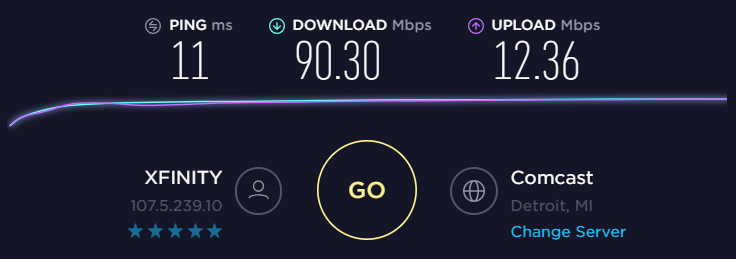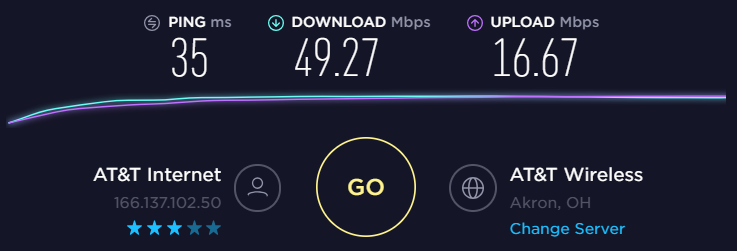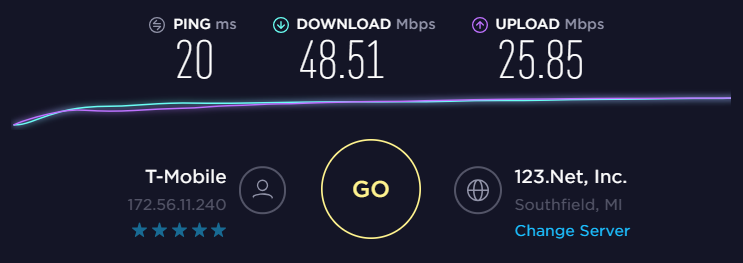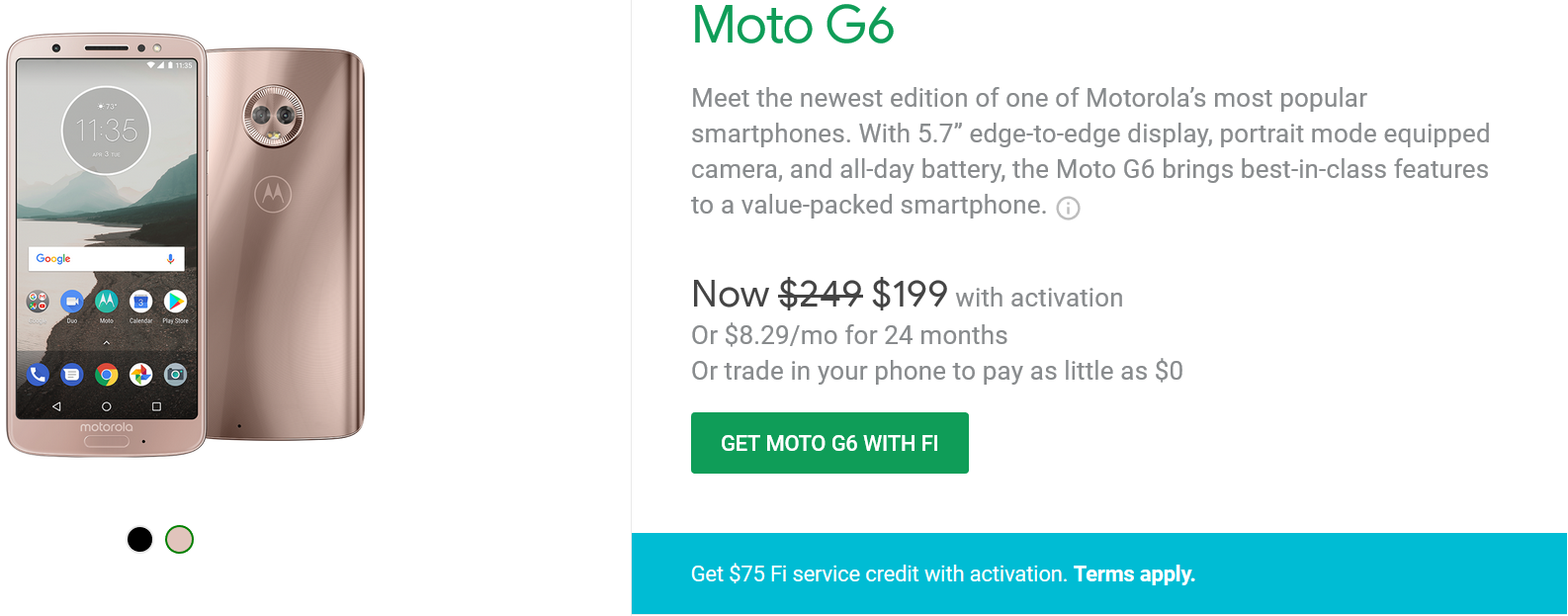NOTICE: This post references card features that have changed, expired, or are not currently available
Last month I described my hunt for a good international data roaming solution: International Roaming: AT&T / Verizon vs. Project Fi vs. T-Mobile vs. Sprint vs. SIMS vs. Hotspots. I’ve been using AT&T for years and service has been very good, but their international plan is expensive if used frequently ($10 per day per phone adds up quickly especially when traveling as a family). Ultimately I decided to give Google Fi phone service a try. At home, Google Fi appears to be similarly priced to its major competitors, especially if you tend to use a lot of data. Fi’s killer feature is that it supports high speed data roaming around the world at no additional cost.
As I reported previously, I was able to activate Google Fi service and get a Fi compatible Android phone for only $200. And, this came with $70 in Google Fi service credit ($50 with the phone + $20 for using a referral). It looks like I should have waited a bit, though, since the same phone now comes with $75 service credit.
If you combine that with $20 credit from accepting a friend referral (here’s mine), it’s now possible to get started for the same price I paid, but with $95 in service credit. That’s a great deal, especially if you need a phone.
In my case, I’m perfectly happy with the phone I currently use (an iPhone 7 Plus), but I needed a Fi compatible phone to activate Google Fi service. Once service is activated, Fi works reasonably well in my iPhone (more on that below). Of course, I could have found a friend with a Fi compatible phone to activate my service. That would have saved me about $150 (I’d get the $20 referral credit either way), but then I wouldn’t have an Android phone…
A little background… I’m a bit of a gadget freak. I don’t necessarily rush out to get the latest gadgets, but I’m always interested in them. And, I kid you not, I even have a mini gadget museum in my house containing things like my first internet enabled phone (T-Mobile Sidekick), the first iPhone, a flip phone, a Windows phone, my first e-book reader, my first GPS device, my first video-enabled MP3 player, a few digital wallet cards, etc. What’s not there is an Android phone. Somehow, through all the years, I’ve never owned an Android phone. If Google Fi offers nothing else, it at least offered me an excuse to pickup an Android phone at very low cost. And now, if I also get a Samsung Gear watch, I can use Samsung Pay by pairing the watch with this Android phone.
Initial Findings…
The phone is surprisingly good
Given that it costs only $200, the Moto G6 is a surprisingly nice phone. It runs well, it seems to have great battery life, and it has a big, bright, and gorgeous screen.
There are negatives, of course. This model has limited storage (32GB), a mediocre camera, and it’s a bit sluggish at times. That said, it’s good enough for most purposes and if you care about looks over substance, you won’t be disappointed.
Domestic service is surprisingly good
Domestically, Google Fi has access to three networks: T-Mobile, Sprint, and U.S. Cellular. A Fi compatible phone is able to automatically switch to whichever carrier has the fastest service. When using Fi with an iPhone, though, it sticks with T-Mobile. In my tests so far, that’s not a problem.
In one of my first tests, I ran Speedtest on my laptop in four scenarios: 1) Connected to Comcast internet via wifi; 2) Connected to AT&T using my iPhone as a hotspot; 3) Connected to T-Mobile using the Moto G6 as a hotspot; and 4) Connected to Sprint using the Moto G6 as a hotspot.




The ability to use my phone to connect my laptop to wifi is important to me. The above tests showed that, from my home, Google Fi could easily handle my needs.
How about around town or away from home?
| AT&T | Google Fi on T-Mobile | |
|---|---|---|
| Ann Arbor Downtown | Download: 26.3 Mbps Upload: 7.91 Mbps |
Download: 1.31 Mbps (Sprint) Upload: 0.21 Mbps (Sprint) |
| Ann Arbor Kerrytown | Download: 75.0 Mbps Upload: 3.64 Mbps |
Download: 45.4 Mbps Upload: 6.56 Mbps |
| Charlottesville (inside hotel) | Download: 3.98 Mbps Upload: 11.1 Mbps |
Download: 12.2 Mbps Upload: 12.9 Mbps |
| Charlottesville (upon a mountain) | Download: 4.28 Mbps Upload: 3.38 Mbps |
Download: 19.6 Mbps Upload: 0.06 Mbps |
My first experience with Google Fi outside of my home was really bad. I was at a restaurant in downtown Ann Arbor and I found that AT&T speeds were very good whereas Google Fi was awful. Luckily, I later discovered that I hadn’t switched the phone off of Sprint (I had previously forced the switch to Sprint to run tests at home). All other tests were with T-Mobile, which worked much better.
Not counting my one Sprint fiasco, I found that Google Fi on T-Mobile tended to be just as good or better than AT&T in most places. Shown above are only the places where I explicitly compared the two. In many other places I spot checked Fi to see if it was working well, and it usually was.
I did run into a Fi failure at Whole Foods in Ann Arbor. Internet speeds were so poor that it was virtually unusable. I don’t have Speedtest data for this experience because the app couldn’t even find the server. Luckily for Fi, AT&T service was just as bad.
Using Fi on an iPhone (Does that make it a FiPhone?)
I’m not currently planning to change my primary phone — I’m happy with my iPhone 7 Plus. So, if I’m going to change my wireless service, I want it to work well with my iPhone. Luckily I had an old iPhone 6 Plus that I could use to test with while I continued to use my primary phone as needed. Here’s what I found when I put my Fi SIM into my old iPhone:
- Carrier: T-Mobile. Apparently you can’t switch to Sprint or U.S. Cellular, but that hasn’t proven to be an issue at all yet.
- Phone service quality: Very good
- Data speeds: Very good
- Use as hotspot (connect laptop to phone data over wifi): Very good
- iMessage: No problems for sending/receiving text, images, etc.
- Text message from Android phone: Works but includes random looking text at the end (e.g. “~wbc91gAJ/Z8B9wg”)
- Emoji sent from Android phone: Same as above. It works, but includes random text at the end.
- MMS from Android phone: Doesn’t work. I found various posts that describe how to setup your iPhone to receive MMS messages and I tried a few approaches, but nothing worked so far. It’s possible (likely even) that I had entered some info incorrectly. This warrants more investigation.
Short answer: Everything worked fine except MMS messages sent from Android phones. This issue can probably be fixed with the right settings, but honestly it’s not something that comes up very often so I’m not too worried about it.
Data-only SIMs
A unique Google Fi feature is that you can order extra data-only SIMs for free. These SIM cards use the same data plan as your phone so they’ll increase your data charges (up to a max data price), but otherwise won’t cost you more. I ordered a couple of these and tried one out long enough to prove that it works, but that’s all I’ve done with it so far.
Theoretically a family could share a single-person Fi phone plan by using these data-only SIMs in different phones as long as each person uses VOIP calling/texting with a service like Google Hangouts. There are two issues with this approach that I can think of:
- Data-only SIMs cannot be used as hotspots (for wifi tethering)
- Data speeds may be throttled after 6 Gig is used up each month
Next test: International service
I’ll be in London in a few weeks and that will be my first chance to test Google Fi’s international data service. I expect it will be quite good, but I’ll let you know.
Wrap Up
So far, I’m really happy with Google Fi service. In most cases Fi over T-Mobile has proven to be as good or better than AT&T. Will I switch over completely? Yes, I’m going to give that a try. If my Google Fi experience then continues to go well I’ll stay with Fi. Otherwise, I’ll go back to AT&T (or to T-Mobile) and I’ll pause Google Fi service. I could then use Fi only when traveling abroad. If that happens, my new Moto G6 can act as my go-everywhere hot-spot. That’s not a bad solution either.
For more about Google Fi, see this post from Running With Miles: The Ultimate FAQ Guide About Google Project Fi – An Awesome Choice for International Travel!






[…] My Google Fi Experience So Far […]
[…] My Google Fi Experience So Far. […]
[…] My Google Fi Experience So Far. […]
[…] Greg has been using the Moto G6 on Project Fi and has written about his experiences with it (See: My Google Fi experience so far). If that has intrigued you, this is a pretty cheap cost of […]
I must be slow or missing something essential about this entire topic. Why aren’t you looking at a dedicated personal hotspot like Skyroam or similar products? They cost less than the phone you bought and can tether up to five devices. My understanding is that you can get better service at a smaller cost, especially where data is involved. Please tell me why Google Fi is superior.
I did discuss Skyroam in my prior post. My primary problem with Skyroam is that the device is ridiculously thick. While it’s possible to jam it into my pants pocket, it’s uncomfortable.
I believe I can tether multiple devices with Google Fi as well. And since Fi caps the data charges each month, it is substantially cheaper than other high speed roaming options I’ve looked at (if you use lots of data).
Hi Greg,
If your iPhone 6 Plus is the AT&T model, that would explain why you can’t connect to either Sprint or US Cellular. Both carriers use CDMA, as opposed to the GSM that both AT&T and T-mobile (and 90%+ of the world’s carriers) use. Your particular model lacks the CDMA radio, so it’s impossible to connect to Sprint and US Cellular.
In addition, I’m wondering if any iPhone can actively switch between carriers, since I assume that the switching is done via a Project Fi app, for which I assume they don’t provide an IOS version.
Gary
I Love Fi and that’s the service I’ve been using for over 2 years. I’ve traveled to Indonesia, Thailand, Cambodia, Vietnam (only calls there, no internet), Canada, Japan, Mexico and works perfectly fine. Won’t change it !
[…] My Google Fi Experience So Far […]
I am thinking about the same as well, because I don’t use that much data in the US, and I want faster data abroad, so both are strengths of Fi, but I don’t know if I can use 1 android device to activate multiple Fi sims? (not data-sims)
Good question! I’ve read that you can only use a phone once to activate Fi. So I’m not sure how one would activate another line unless you have another Fi compatible phone
Why not just switch to T-Mobile at this point? Seems easier and sprint is garbage you’re not enjoying anyway
High speed international data.
Please review the Glocal hotspot. Thanks for doing this series. I’m also looking for a good option
I’ve been using Fi for over 3y and no issues so far. I’ve visited many countries, and always had good connectivity. However, the speed is capped at 3G, so you won’t get LTE speed. Calling the US from abroad is free and non WiFi calls are also cheaper than others (skype).
I also recommend using apps such as https://play.google.com/store/apps/details?id=com.mbmc.fiinfo&hl=en_US to be able to see what network you’re using.
One of the first comments above mentioned 3G and LTE speeds in china?
Greg, where did you see the $75 service credit for Moto G6? Not seeing it at https://fi.google.com/about/phones/#moto-g6
Interesting… it looks like they took away the credit. Maybe check again next week
Whaaat.. It was there when I checked 2 days ago
The service credit offer still has not returned to this phone…two other phones qualify for service credits, but not the Moto G6.
A great thing about the Moto G6 is that the memory can be expanded up to 160GB with an inexpensive microSD card.
That’s too bad about the Moto credit going away, but good to know about expanding its memory. I just wish it had a decent camera.
I have the Moto G5+, one generation back from the G6. The camera is actually pretty good. I see that the G6 has a dual camera, so it can do a bokeh effect for portraits. It can also do related effects, like make the close-up object (typically a face) in color and the background b/w.
Good to know! I’ve only taken photos so far in low light and they came out awful compared to what I’m used to with my iPhone 7+. I’ll have to google how to do those effects with the camera. It’s not obvious
This is a fantastic recap and I really appreciated reading it. One thing I either missed or perhaps would be beneficial to add is some detail on cost of Google Fi services.
I got that the phone was $200 and there were incentives/rebates, but the monthly service structure…$50/month? $100/month? $1/month? I’m sure there are a variety of “options” but would have been nice to have a few basic touch-points to have some understanding of the cost.
For one person:
$20/mo for calls and text
+ $10/Gb for data (max $60)
= $80/mo max
Pricing gets a little more complicated with multiple lines of service. The Fi website makes it very easy to calc pricing
Hi Greg, so when you are using it only as a hotspot, are you having to pay for data? Or can you just get by with $20 a month?
Yes, the data you use for the hotspot adds to your monthly total data usage. It has the same $80 max either way.
I’ve used google fi as my primary service due to a lot of international travel in the last few years. Was great internationally, but coming back to the US, the cell networks are always a disappointment. There is a reason T-mobile and Sprint cost so much less than Verizon and ATT – their networks aren’t as vast. Especially out west and in places with topography.
I keep it due to the ability to send/receive text messages over the internet in addition to the cell network – this works seamlessly with all types of phones on the other end (unlike iMessage which is Apple only). My work building has a lot of cell dead spots…
I don’t use a lot of data, so my bills are manageable and the recently bill protection ($80 cap, up to 15gb before throttle) is decent, but there are better unlimited plans in the USA for sure.
A minor annoyance is that my phone (pixel 2) seems to hunt a bit more for the network as it can switch between gsm and cdma which I think that drains the battery faster. It just seems to have a slightly harder time finding the best network especially when coming out of a building or something. Going with a gsm only phone would fix that, but obviously restrict to T-Mobile .
With Fi, there are some dead spots for many miles when I drive in more rural places and the mountains, so I’ve actually picked up an xfinity mobile (Verizon mvno, basically free talk/txt with xfinity cable) second phone to stash in the car.
It’s a really good niche service that’s not going to be the best for everyone.
Good to know, thanks!